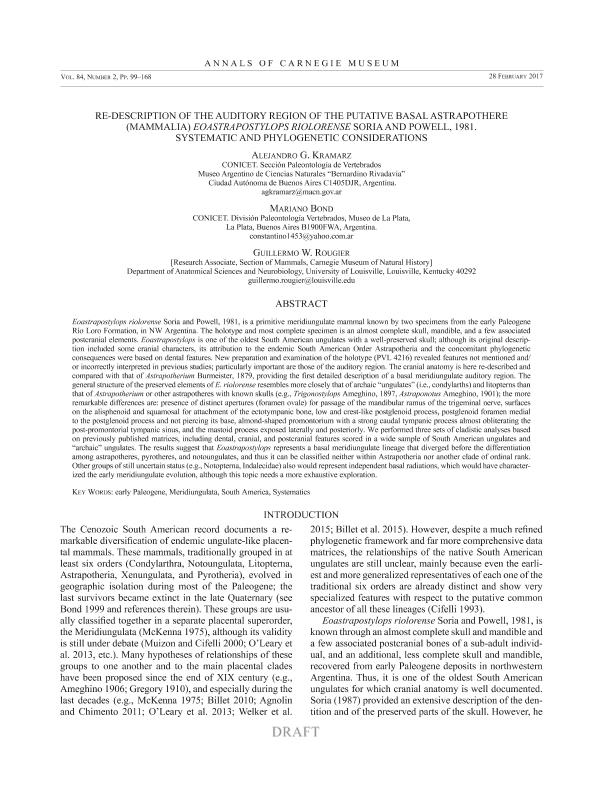Artículo
Re-Description of the Auditory Region of the Putative Basal Astrapothere (Mammalia) Eoastrapostylops riolorense Soria and Powell, 1981. Systematic and Phylogenetic Considerations
Fecha de publicación:
03/2017
Editorial:
Carnegie Museum Natural History
Revista:
Annals Of Carnegie Museum
ISSN:
0097-4463
e-ISSN:
1943-6300
Idioma:
Inglés
Tipo de recurso:
Artículo publicado
Clasificación temática:
Resumen
Eoastrapostylops riolorense Soria and Powell, 1981, is a primitive meridiungulate mammal known by two specimens from the early Paleogene Río Loro Formation, in NW Argentina. The holotype and most complete specimen is an almost complete skull, mandible, and a few associated postcranial elements. Eoastrapostylops is one of the oldest South American ungulates with a well-preserved skull; although its original description included some cranial characters, its attribution to the endemic South American Order Astrapotheria and the concomitant phylogenetic consequences were based on dental features. New preparation and examination of the holotype (PVL 4216) revealed features not mentioned and/ or incorrectly interpreted in previous studies; particularly important are those of the auditory region. The cranial anatomy is here re-described and compared with that of Astrapotherium Burmeister, 1879, providing the first detailed description of a basal meridiungulate auditory region. The general structure of the preserved elements of E. riolorense resembles more closely that of archaic “ungulates” (i.e., condylarths) and litopterns than that of Astrapotherium or other astrapotheres with known skulls (e.g., Trigonostylops Ameghino, 1897, Astraponotus Ameghino, 1901); the more remarkable differences are: presence of distinct apertures (foramen ovale) for passage of the mandibular ramus of the trigeminal nerve, surfaces on the alisphenoid and squamosal for attachment of the ectotympanic bone, low and crest-like postglenoid process, postglenoid foramen medial to the postglenoid process and not piercing its base, almond-shaped promontorium with a strong caudal tympanic process almost obliterating the post-promontorial tympanic sinus, and the mastoid process exposed laterally and posteriorly. We performed three sets of cladistic analyses based on previously published matrices, including dental, cranial, and postcranial features scored in a wide sample of South American ungulates and “archaic” ungulates. The results suggest that Eoastrapostylops represents a basal meridiungulate lineage that diverged before the differentiation among astrapotheres, pyrotheres, and notoungulates, and thus it can be classified neither within Astrapotheria nor another clade of ordinal rank. Other groups of still uncertain status (e.g., Notopterna, Indalecidae) also would represent independent basal radiations, which would have characterized the early meridiungulate evolution, although this topic needs a more exhaustive exploration.
Palabras clave:
Paleogene
,
Meridiungulata
,
Systematics
,
Eoastrapostylops
Archivos asociados
Licencia
Identificadores
Colecciones
Articulos(CCT - LA PLATA)
Articulos de CTRO.CIENTIFICO TECNOL.CONICET - LA PLATA
Articulos de CTRO.CIENTIFICO TECNOL.CONICET - LA PLATA
Articulos(MACNBR)
Articulos de MUSEO ARG.DE CS.NAT "BERNARDINO RIVADAVIA"
Articulos de MUSEO ARG.DE CS.NAT "BERNARDINO RIVADAVIA"
Citación
Kramarz, Alejandro Gustavo; Bond, Mariano; Rougier, Guillermo Walter; Re-Description of the Auditory Region of the Putative Basal Astrapothere (Mammalia) Eoastrapostylops riolorense Soria and Powell, 1981. Systematic and Phylogenetic Considerations; Carnegie Museum Natural History; Annals Of Carnegie Museum; 84; 2; 3-2017; 95-164
Compartir
Altmétricas




